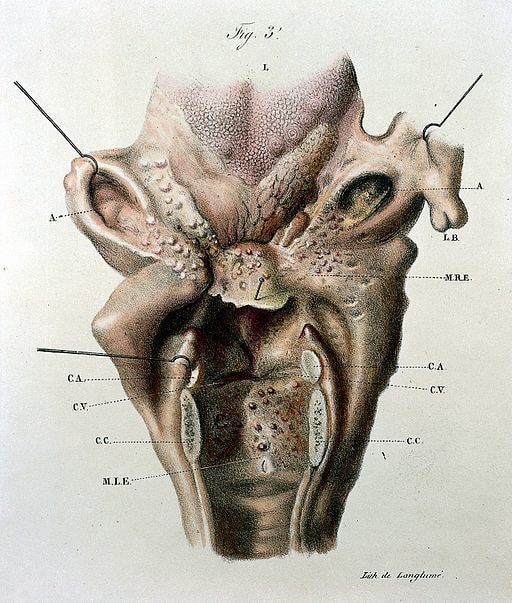WILLIAM CHESELDEN (1688-1752). Osteographia; or, The anatomy of the bones. London: [n. publ.], 1733. Cheselden’s reputation as a teacher, clinician, and anatomist was well established during his lifetime, and he won great distinction in London’s hospitals. His work on human anatomy went through thirteen editions and became a standard textbook. His Osteographia, with its magnificent plates depictingContinue reading “Osteographia, The Anatomy of the Bones | April 2018 Notes from the John Martin Rare Book Room @Hardin Library”
Category Archives: Notes from the Rare Book Room
Icones Anatomicae, 1801-1813 | February 2018 Notes from the John Martin Rare Book Room @Hardin Library
LEOPOLDO MARCO ANTONIO CALDANI (1725-1813) and FLORIANO CALDANI (1772-1836). Icones anatomicae., 1801-1813 Leopoldo Caldani was chair of anatomy at Padua, and was assisted in the publication of his anatomical works by his nephew, Floriano Caldani, also a professor at Padua. Together, they created this massive, beautiful compilation of the best anatomic representations of past years.Continue reading “Icones Anatomicae, 1801-1813 | February 2018 Notes from the John Martin Rare Book Room @Hardin Library”
November 2017 Notes from the John Martin Rare Book Room | Ars moriendi = The Art of Dying
Ars moriendi. [Cologne, Heinrich Quentell, c. 1495] Although the author of Ars moriendi is not known, the book is believed to have been written in Southern Germany at the time of the Council of Constance (1414-1418). Ars moriendi, or The art of dying, was intended to instruct the reader on the proper modes of behaviorContinue reading “November 2017 Notes from the John Martin Rare Book Room | Ars moriendi = The Art of Dying”
Paracelsus, father of toxicology | October 2017 Notes from the John Martin Rare Book Room @Hardin Library
PARACELSUS (1493-1541). Opera, Bücher und Schrifften. Strasbourg: In Verlegung L. Zetzners seligen Erben, 1616. Philippus Theophrastus Bombastus von Hohenheim is universally known as Paracelsus. He was born in Switzerland and educated at Basel. Paracelsus unorthodox ideas and teachings put him in conflict with the orthodox establishment of his revolutionary time and he spent most of hisContinue reading “Paracelsus, father of toxicology | October 2017 Notes from the John Martin Rare Book Room @Hardin Library”
Major, Chirugia Infusoria | Blood Transfusion | September 2017 Notes from the John Martin Rare Book Room @Hardin Library
JOHANN DANIEL MAJOR (1634-1693). Chirurgia infusoria. Kiel: Sumptibus Joh. Lüdervvald, Impremebat Joach. Reumannus, 1667. Major, a native of Breslau, Germany, received his second medical degree at Padua in 1660. He practiced medicine at Hamburg and Wittenberg before being appointed the first professor of medicine at Kiel in 1665. Major was a physician, a naturalist, collector,Continue reading “Major, Chirugia Infusoria | Blood Transfusion | September 2017 Notes from the John Martin Rare Book Room @Hardin Library”
Abu al-Qasim | August 2017 Notes from the John Martin Rare Book Room @Hardin Library
ABU AL-QASIM (d. 1013?). Liber theoricae necnon practicae Alsaharavii. [Augsburg: Impensis Sigismundi Grimm, & Marci Vuirsung, 1519]. Abu al-Qasim (or Abulcasis, or Albucasis, as he is variously known), a native of Cordova in Moorish Spain, may be classed with Avicenna in the importance of his great medical encyclopedia, al-Tasrif. Kitab Al-Tasrif was originally published in 30Continue reading “Abu al-Qasim | August 2017 Notes from the John Martin Rare Book Room @Hardin Library”
ANDRÉ DU LAURENS | July 2017 Notes from the John Martin Rare Book Room @Hardin Library
ANDRÉ DU LAURENS (1558-1609). De mirabili strumas sanandi vi solis Galliae regi-bus christianissimis divinitus concessa liber unus. Paris: Apud Marcum Orry, 1609. Du Laurens taught at Montpellier until 1598 when he was called to Paris as court physician. In this position he eventually became personal physician to Marie de Medici and King Henry IV. DuringContinue reading “ANDRÉ DU LAURENS | July 2017 Notes from the John Martin Rare Book Room @Hardin Library”
Fabricius, De visione, voce, auditu | June 2017 Notes from the John Martin Rare Book Room @Hardin Library
HIERONYMUS FABRICUS ab Aquapendente (ca. 1533-1619). De visione, voce, auditu. 3 parts in 1 volume. Venice: Per Franciscum Bolzettam, 1600. One of the great Paduan anatomists and teachers, pupil of Fallopius, teacher of Harvey, and friend of Galileo, Fabricius built the first anatomical theater for public dissections at Padua, which is still preserved intact. DeContinue reading “Fabricius, De visione, voce, auditu | June 2017 Notes from the John Martin Rare Book Room @Hardin Library”
Jean Cruveilhier | April 2017 Notes from the John Martin Rare Book Room @Hardin Library
JEAN CRUVEILHIER (1791-1874). Anatomie pathologique du corps humain. 2 vols. and atlas. Paris: J.-B. Baillière, 1829-1842. In the nineteenth century pathology came into its own, based on increasingly accurate knowledge of pathological anatomy. Cruveilhier was the first occupant of the newly established chair of pathology at the University of Paris. Cruveilhier was the first to giveContinue reading “Jean Cruveilhier | April 2017 Notes from the John Martin Rare Book Room @Hardin Library”
February 2017 Notes from the John Martin Rare Book Room @Hardin Library | Karl Ernst von Baer
KARL ERNST VON BAER (1792-1876). De ovi mammalium et hominis genesi. Leipzig: Sumptibus L. Vossii, 1827. Baer was an early pioneer of modern embryology who, through painstaking and patient effort, investigated germ cell line-age of a variety of species, firmly establishing embryology as a comparative science. While a professor in Königsberg, Baer wrote his most significantContinue reading “February 2017 Notes from the John Martin Rare Book Room @Hardin Library | Karl Ernst von Baer”









